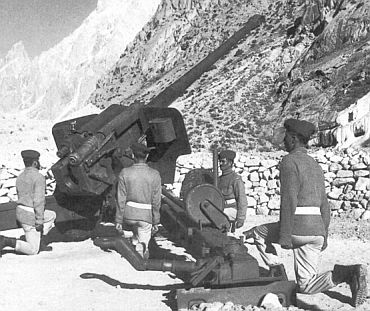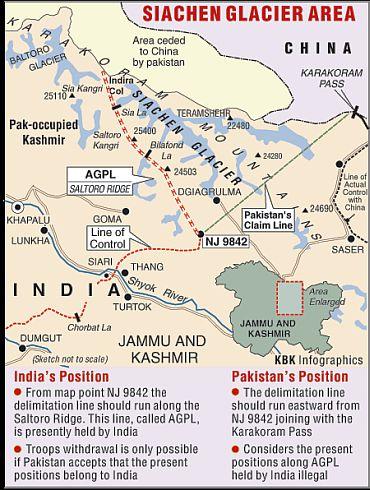Ajai Shukla
For the Indian Army, Siachen symbolises a superhuman feat of arms, sustained over decades. All that Indian Army generals are hoping is that all their effort is not undone by the latest round of Indo-Pak talks on Siachen, reports Ajai Shukla
On a moonless night in Siachen, in May 1987, Second Lieutenant Rajiv Pande's thirteen-man patrol silently climbed towards Quaid Post, a 21,153-feet high pinnacle near the crucial Bilafond La pass that was held by 17 Pakistani soldiers.
Quaid had to be captured and Pande was fixing ropes on the near-vertical, 1500-feet ice wall just below the post, to assist a larger follow-on force in making a physical assault.
As the jawans fixed the ropes, gasping for breath in that oxygen-depleted altitude, the Pakistani sentries just a few hundred feet above heard them. Gunfire rang out killing nine Indian soldiers, including Pande. But the four survivors could tell their unit, 8 Jammu & Kashmir Light Infantry (8 JAK LI), that the ropes were fixed.
Capturing Quaid post was vital being the only Pakistani post that dominated key Indian positions at Bilafond La. Realising its importance, Pakistan named it after Qaid-e-Azam Mohammad Ali Jinnah. The post, commanded by Subedar Ataullah Mohammed, was held by commandos from the elite Special Services Group.
...
Siachen talks with Pak: Generals watch and hope
With the ropes in place, 8 JAK LI helicoptered an assault team to Bilafond La. Since the Cheetah helicopter can only ferry a single passenger in those extreme heights, and because of frequent blizzards, it took 25 days for the team to gather.
On June 23, sixty-four soldiers, commanded by Major Virendar Singh, began the attack. All night they searched in waist-deep snow for the rope fixed by Pande's patrol. Unable to find it, they fell back to base.
The next night a silent cheer went up as the rope was found. In single file, with their rifles slung across their backs, the first section (10 men) started the ascent to Quaid, crossing en route the bodies of Pande and his patrol, still roped together in death.
Halfway up, the Pakistani defenders spotted them and opened a murderous fire.
Siachen talks with Pak: Generals watch and hope
Pinned to the ice wall and unable to fire back --- their weapons had suffered "cold arrest", jammed solid from the minus 25 degree cold --- the assault team sheltered in craters formed by artillery shells. There they spent the entire day exposed, frozen, hungry and under Pakistani fire.
At nightfall on the 25th, the attack began anew. Now the neighbouring Indian posts ---Sonam and Amar --- also fired at Quaid, supplementing an artillery barrage. But each metre gained was paid for in blood; every Indian casualty needed four comrades to ferry him down. A brief rest, a cup of tea, and the four helpers were thrown back into battle.
"By any measure, we should have dropped from exhaustion", said Major Virendar Singh, describing the events to Business Standard. "But Pande had to be avenged, and the relentless firing from Quaid reminded us of what we had to do."
Siachen talks with Pak: Generals watch and hope
By daybreak on the 26th, it became evident that capturing Quaid post would need a daylight frontal assault. With the entire army brass' attention riveted on this unfolding drama, the brigade commander, Brigadier Chandan Nugyal, radioed Virendar, promising him fire support from every artillery gun in range if he could finish the job.
"I knew we would not last another night on a bar of 5-Star chocolate. We fixed the attack for noon," says Virendar.
After a massive barrage of artillery fire, Virendar closed onto the post with his 8-man assault party. Simultaneously, another small team outflanked Quaid from below and cut the ropes that the Pakistanis used. Subedar Mohammad knew the game was up.
Four defenders jumped off the post, preferring instant death in the abyss below to being shot or bayoneted in combat. The two who remained were quickly killed. By 3 pm the Indian assault party staggered onto Quaid.
Siachen talks with Pak: Generals watch and hope
"We had no strength to celebrate. At 21,000 feet, nobody does the bhangra, yells war cries, or hoists the tricolour. Ultimately, sheer doggedness wins. If we had once hesitated, Quaid would still be with Pakistan," recounts Virendar.
An admiring army awarded a Param Vir Chakra to Naib Subedar Bana Singh of the assault party and renamed Quaid post Bana Top; and a Maha Vir Chakra and 7 Vir Chakras to other bravehearts of 12 JAK LI. Virendar, who was severely wounded by an artillery shell after Quaid post was captured, won a Vir Chakra, as did Lieutenant Pande.
Indian posts across Siachen, like Bana Top, many of them won at similar cost, will be on the negotiating table on Monday and Tuesday, as the defence secretaries of India and Pakistan meet for the 12th round of dialogue to resolve the Siachen dispute.
Siachen talks with Pak: Generals watch and hope
The Pakistan Army -- for whom Siachen represents a stinging defeat at the hands of the Indian Army -- wants to erase that memory by "demilitarising" Siachen. It wants both sides to vacate their positions and pull back to an agreed line, well short of the glacier.
But the Indian Army has little trust for its Pakistani counterpart after the Kargil intrusion and years of fighting terrorism. It asks: how do we know that Pakistan will not reoccupy Siachen after we withdraw? How can you assure us that we will not have to capture Bana Top again?
During 11 previous rounds of dialogue New Delhi had demanded a signed map from Pakistan, showing its forward troop locations, as a prerequisite for a Siachen settlement. Pakistan demurs, ostensibly because that would "legitimise" India's "intrusion" into Siachen.
Rawalpindi's refusal to authenticate its positions has scuttled all previous dialogue. The reason for that reluctance, the Indian Army believes, is that a signed map would clearly show how badly Pakistan was beaten in Siachen.
Siachen talks with Pak: Generals watch and hope
Although Pakistan terms it "the Siachen dispute", its forward-most positions cannot even see the glacier. From April 13, 1984, when an all-volunteer Indian force was helicoptered to the Bilafond La pass, India's complete control of the Saltoro Ridge has shut Pakistan out of Siachen.
Over the years, at enormous cost in dead and injured, the Indian Army has developed enormous skill at surviving at "super altitudes".
In the 1980s, casualties from frostbite and altitude sickness ran in the hundreds. By the end of the last decade, they were down to 20-22 per year. During the last eight years, nobody has died. Today, barely 10-12 soldiers are evacuated annually.
Prime Minister Manmohan Singh has termed Siachen "a mountain of peace", and has tended to view it as a bargaining chip in the larger dialogue process with Pakistan.
For the Indian Army, though, Siachen symbolises a superhuman feat of arms, sustained over decades. Generals today recall that the blood-soaked capture of the strategic Haji Pir Pass in 1965 was undone at the negotiating table in Tashkent. And many wonder whether history is about to repeat itself.









article